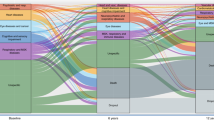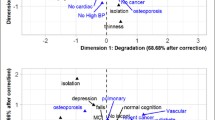Abstract
Elderly patients are commonly characterized by the presence of several chronic aging-related diseases at once, or old-age “multimorbidity,” with critical implications for diagnosis and therapy. However, at the present there is no agreed or formal method to diagnose or even define “multimorbidity.” There is also no formal quantitative method to evaluate the effects of individual or combined diagnostic parameters and therapeutic interventions on multimorbidity. The present work outlines a methodology to provide such a measurement and definition, using information theoretical measure of normalized mutual information. A cohort of geriatric patients, suffering from several age-related diseases (multimorbidity), including ischemic heart disease, COPD, and dementia, were evaluated by a variety of diagnostic parameters, including static as well as dynamic biochemical, functional-behavioral, immunological, and hematological parameters. Multimorbidity was formally coded and measured as a composite of several chronic age-related diseases. The normalized mutual information allowed establishing the exact informative value of particular parameters and their combinations about the multimorbidity value. With the currently intensifying attempts to reduce aging-related multimorbidity by therapeutic interventions into its underlying aging processes, the proposed method may outline a valuable direction toward the formal indication and evidence-based evaluation of effectiveness of such interventions.
Similar content being viewed by others
References
Blokh D, Stambler I (2015a) Information theoretical analysis of aging as a risk factor for heart disease. Aging Dis 6(3):196–207
Blokh D, Stambler I (2015b) Applying information theory analysis for the solution of biomedical data processing problems. Am J Bioinform 3(1):17–29
Blokh D, Stambler I (2016) The application of information theory for the research of aging and aging-related diseases. Prog Neurobiol. https://doi.org/10.1016/j.pneurobio.2016.03.005
Blokh D, Stambler I (2017) The use of information theory for the evaluation of biomarkers of aging and physiological age. Mech Ageing Dev 163:23–29
Dodds TA, Martin DP, Stolov WC, Deyo RA (1993) A validation of the functional independence measurement and its performance among rehabilitation inpatients. Arch Phys Med Rehabil 74:531–536
Fontana L, Kennedy BK, Longo VD, Seals D, Melov S (2014) Medical research: treat ageing. Nature 511(7510):405–407
Goldman DP, Cutler D, Rowe JW, Michaud PC, Sullivan J, Peneva D, Olshansky SJ (2013) Substantial health and economic returns from delayed aging may warrant a new focus for medical research. Health Aff 32(10):1698–1705
Hall SS (2015) A trial for the ages. Science 349(6254):1275–1278
Jin K, Simpkins JW, Ji X, Leis M, Stambler I (2015) The critical need to promote research of aging and aging-related diseases to improve health and longevity of the elderly population. Aging Dis 6(1):1–5
Linacre JM, Heinemann AW, Wright BD, Granger CV, Hamilton BB (1994) The structure and stability of the Functional Independence Measure. Arch Phys Med Rehabil 75:127–132
Newman JC, Milman S, Hashmi SK, Austad SN, Kirkland JL, Halter JB, Barzilai N (2016) Strategies and challenges in clinical trials targeting human aging. J Gerontol A Biol Sci Med Sci 71(11):1424–1434
Salive ME (2013) Multimorbidity in older adults. Epidemiol Rev 35(1):75–83
Rae MJ, Butler RN, Campisi J, de Grey AD, Finch CE, Gough M, Martin GM, Vijg J, Perrott KM, Logan BJ (2010) The demographic and biomedical case for late-life interventions in aging. Sci Transl Med 2(40):40cm21
Semba RD, Nicklett EJ, Ferrucci L (2010) Does accumulation of advanced glycation end products contribute to the aging phenotype? J Gerontol A Biol Sci Med Sci 65A(9):963–975
Author information
Authors and Affiliations
Corresponding author
Ethics declarations
Conflict of interest
The authors declare that they have no conflict of interest.
About this article
Cite this article
Blokh, D., Stambler, I., Lubart, E. et al. The application of information theory for the estimation of old-age multimorbidity. GeroScience 39, 551–556 (2017). https://doi.org/10.1007/s11357-017-9996-4
Received:
Accepted:
Published:
Issue Date:
DOI: https://doi.org/10.1007/s11357-017-9996-4




